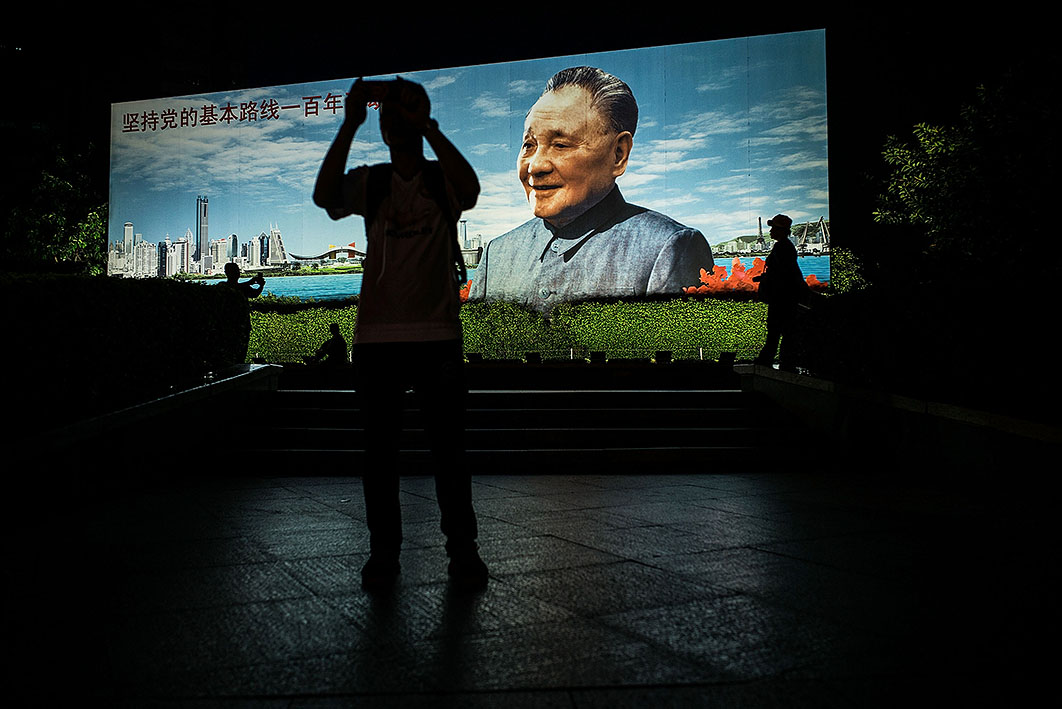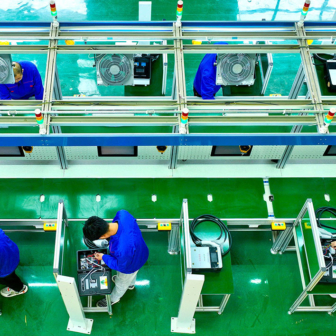China’s first forty years of pro-market growth have been spectacular by any count, but they are ending badly. The country’s biggest customer, the United States, has mounted a trade war that tramples on global trading rules.
Initial hopes of a quick diplomatic solution have been dashed. Instead, Donald Trump has widened the conflict, and promised to widen it further, massively. It is not clear when, or how, it will end — and the damage could be significant, to China and the world.
Last Friday, global experts on the Chinese economy gathered in Canberra for the Australian National University’s annual China Update. The plan was to look back over the triumphs and tribulations of the forty years since former Chinese leader Deng Xiaoping began steering the country towards market reforms in 1978. But any nostalgia was overshadowed by alarm at where this trade war could take us.
There was no consensus about what China should do to try to end the dispute, and it seemed useless to discuss what the United States should do. And there was no dissent when keynote speaker Professor Yiping Huang, of Peking University, warned that this war could be a long one.
Economic and political issues have become entangled, he said. There are four separate issues, and their rights and wrongs are mixed. No obvious and politically plausible solution exists — even if it were clear that Trump wants the dispute solved, which it isn’t.
In case you’ve spent the last month hanging out in some deep cave in Thailand, I should recap. On 6 July the Trump administration imposed US$34 billion per year in punitive tariffs on Chinese exports to the United States, with US$16 billion more to come. Four days later, after China retaliated in kind, Trump ordered officials to prepare tariff hikes on a further US$200 billion of Chinese exports. All this is in addition to his earlier hikes on imports of steel and aluminium from virtually anywhere — and his even earlier tariffs on (mainly Chinese) solar panels and (mainly Korean) washing machines.
The United States says its actions are intended to redress its merchandise trade deficit of US$370 billion with China and Hong Kong, and to retaliate for various alleged Chinese actions, including the widespread theft of US intellectual property, hidden state subsidies for Chinese manufacturers, and a services sector that remains largely closed to foreign firms despite repeated promises to open it up.
At the gathering of experts, an hour-long session allocated to the dispute ran thirty-five minutes overtime as various solutions were debated and discarded. The Australian contingent mostly urged China not to retaliate, as that would only widen the dispute. Modelling by the ANU’s Jenny Gordon had found that the potential loss of confidence among global investors would do more damage than the tariffs themselves.
But to do nothing is politically unfeasible, replied the Chinese economists, and the Americans — none of whom supported Trump’s actions — agreed. Harvard University’s veteran China-watcher Dwight Perkins intervened to point out that the dispute was seen as primarily a political rather than an economic issue in the United States — and it has only strengthened Trump politically.
“You’re not winning the war in terms of what [American] people think should happen,” Perkins told his Chinese colleagues. “It’s a Trump victory. He can be the centre of attention, and [in his mind] he’s got to be the centre of attention.” Far from abstaining, one way China could help end the conflict would be by imposing retaliatory tariffs on US imports. “Anything that hurts politically might be a partial road to a solution,” he said.
So far, the United States has presented China with unilateral demands; to comply with them would be intensely humiliating for president Xi Jinping, whose foreign policy is focused on China asserting its proper place in the world. Within the United States, Trump seems to be under no pressure to find a solution, and his redneck base loves to see him taking on China. It is not clear what compromise solution Trump would accept.
The Nikkei Asian Review this week published an intriguing piece by Katsuji Nakazawa that joined the dots on a series of apparently unrelated events to speculate that some in the Chinese hierarchy might be pushing back against Xi’s handling of the issue. Nakazawa claims there is a growing realisation among the elite that a protracted dispute could cost China heavily, on many fronts. I have no idea whether he is right, but those risks are real.
And it is not just China’s problem, it is the world’s. Professor Huang cited the iPhone: while it is exported from China, he said, it is simply assembled there, from components mostly made in other countries — Taiwan, Korea, Malaysia, wherever. “It might cost US$500 in the US, but only 5 per cent of it is made in China,” he said. Yet the new US tariffs are based on the full US$500 value.
China has become the assembly plant of the world, and Chinese economists have estimated that almost two-thirds of the value of its exports come from other countries, as imported raw materials or components (such as Australian coal and iron ore). An extended trade war between China and the United States would cause fallout everywhere.
What to do? The economists universally denounced the idea that the United States is entitled to discriminate against Chinese imports because it has a trade deficit with China. International trade is never balanced. Last year, for example, Australia ran a combined $60 billion surplus on trade in goods and services with China and Hong Kong, but a deficit of $25 billion with the United States. On Trump’s logic, we would be entitled to impose discriminatory tariffs on US exports, and China would be entitled to do the same to us.
But Professor Huang suggested that China should give ground on the issues where the US demands match its own reform plans. Intellectual property, for example: Chinese reforms are already well under way, and are bearing results — Chinese courts have upheld the claims of foreign firms in 85 per cent of cases they have brought alleging intellectual property violations by Chinese firms — but there is more work to do.
“Protection of intellectual property rights is in the interests of the Chinese economy,” Huang added. “Without protection of intellectual property rights, there is no future for the economy.” (Especially as China aims to become a global leader itself in high technology.)
Similarly, China has already reduced its import tariffs over the past twenty years from 43 per cent on average to 15 per cent (when it joined the World Trade Organization in 2001) and then to 10 per cent. But it should do more to open up to the world, especially in services. This was part of the reform agenda Xi Jinping set out in 2013, but it has gathered dust as his priorities have shifted.
Others at the conference joined Professor Huang (whose views are encapsulated in his recent commentary for the Financial Review) in questioning other aspects of the US case against China, such as its claims of hidden support for manufacturing exports. Nicholas Lardy of Washington’s Peterson Institute for International Economics estimated that while China’s state-owned enterprises receive the bulk of lending from state-owned banks, they now produce only 8 per cent of manufacturing output. Indeed, China’s lending policies seem to discriminate against the very firms it is relying on to lead its transition into high tech, as envisaged in its Made in China 2025 policy.
Many other interesting issues were raised at the conference, with speakers exploring some of China’s vulnerabilities and recent shifts. Among other things:
● Wang Xiaolu, deputy director of the National Economic Research Institute in Beijing, noted that colossal overinvestment in the past decade means that industry is now operating at only 60 per cent of capacity. (In Australia, around 80 per cent is normal.) The overinvestment also left firms with massive debts: his unofficial estimate is that their debt-to-equity ratio is now 2.5–1, compared to half that a decade ago.
● Xin Meng and Bob Gregory, of the ANU, told the conference that net migration of rural workers to the cities has effectively stopped, without explanation or obvious cause. Dr Meng said one hundred million workers moved from farms to cities in the decade to 2007, but migration has virtually stopped in the past three years, with farm workers instead staying in their villages and earning second incomes by working in the local town.
● There was lively debate over whether China is still a state-dominated economy. Nicholas Lardy noted that the private sector now generates between 70 and 75 per cent of its GDP, provides 85 per cent of employment, and produces 90 per cent of exports. The government sets prices for only 2 per cent of retail sales, and 10 per cent of producer purchases. Moreover, he said, China has an extraordinary level of competition; very few industries are dominated by a handful of firms.
● But Professor Barry Naughton, of the University of California, San Diego, argued that the Chinese economy will remain state-dominated as long as the government controls finance and attempts to steer enterprises to its will. While industry is mostly in private hands, he said, the state still dominates the financial sector, communications, education and the scientific and technological frontiers.
● Naughton also joined conference founder and co-host Ross Garnaut in warning against the increasing role President Xi has given to Communist Party committees within state enterprises. Those changes, he said, mean that “the major decisions must be made first by the party committee, then by the enterprise board.” This trend has matched a stunning fall in the rate of return earned by state-owned enterprises, from 6.7 per cent in 2007 to an average of 3 per cent over the past three years.
Professor Garnaut, now at the University of Melbourne, was generally optimistic about China’s prospects. But he warned that many state enterprises are losing money and that “increased centralised concentration of authority” carries risks for China in a world where high-income countries are overwhelmingly democracies. (Indeed, Professor Huang unearthed a 1997 paper by Garnaut, his old mentor, in which he forecast that China’s increasing role in the world was likely to see established Western countries push back against it — prophetic words!)
China is certainly trying to slow or reverse its colossal overinvestment in steel, aluminium, and coal-fired electricity. But these are huge ships, and they take a long time to turn around. China still burns more coal than all other countries combined; last year it produced 57 per cent of the world’s aluminium and 49 per cent of its steel. The damage this overinvestment has done to the world’s economy and climate will take decades to unravel.
Even now, with air pollution in Chinese cities at critical levels and more than a thousand coal-fired power plants closed or shelved, China remains the main driver of global coal demand. The Global Coal Plant Tracker published by anti-coal campaigners CoalSwarm shows that almost half the world’s new coal-fired generation under construction is in China. That’s a lot less than in the past decade, when China built 70 per cent of the world’s new coal-fired generation. But even in 2017, after global commitments to new coal generation had shrunk to just a third of their 2015 level, the International Energy Agency reported that half of the remaining investments came from China. It will be a long time before this story plays out.
One last word. Justin Yifu Lin is probably China’s best-known economist. That’s surprising, since he was born in Taiwan. A rugged guy, he was an officer in the Taiwanese army when, guarding an island in the strait separating China from Taiwan in 1979, he decided to defect — by swimming to the nearest Chinese island. When his bona fides were eventually accepted there, he migrated to Beijing and studied economics. A Chicago PhD followed, and much else, including a stint as chief economist of the World Bank from 2008 to 2012.
These days he too is a professor at Peking University, and his speech to the conference celebrated China’s achievements. China, he told us, would be a high-income country by 2025, escaping the “middle-income trap” that had seen other countries’ growth rates slow down as they left poverty behind.
China’s productivity would grow much faster than that of the United States, he said, because of the rapid improvement in average education levels, the advantages of being such a huge economy and thus able to enter every new field, and the “inherent ability” of its people. He pointed to a global study of the top fifty “unicorns” — start-up companies that are now worth US$1 billion — which found that twenty-six of them were Chinese firms.
He estimated that China could potentially sustain 8 per cent growth over the next decade, but that the weakness in the global economy makes it more likely to grow by 6.5 per cent a year to 2025, and 5 per cent thereafter.
At this, your scribe boiled over. The International Monetary Fund’s database, using China’s own figures, estimates that China’s GDP per head this year is US$18,066 in real (purchasing power parity) terms. That’s just below the global average of US$18,087, and less than a third of the average of the thirty-nine countries the IMF groups as “advanced economies,” which is US$55,004.
That’s some gap to close. Even assuming China keeps growing at this pace, the IMF projects that while its GDP per head will have climbed to US$26,086 by 2023, the average for the advanced economies by then will be US$60,294. Even Greece, now the tail-ender among advanced economies, would still be much richer than China, as would Russia, Turkey and numerous other countries outside the top group.
Lin explained that he was referring to the World Bank classification of “high-income,” which measures income using exchange rates. Well, I have written recently about how misleading exchange-rate measures are, and the World Bank figures only confirm this. Its threshold for “high-income countries” was set in 1987 at US$6000, and has simply been updated each year for inflation.
Under this measure, a country’s ranking depends on the value of its currency. Russia was a high-income country until the West imposed sanctions in 2015; the rouble plummeted, so Russia slid out of the group. Yet Russians overwhelmingly buy Russian goods and services, so they were only briefly and very slightly less “high-income” in real terms.
The updated threshold is now US$12,055, which is so low that eighty-one countries — including Argentina, Poland and Croatia, the Gulf states and much of the Caribbean — are classified “high-income.” That doesn’t mean high-income in the sense that we, the United States and Western Europe are high-income countries. China is welcome to join the World Bank’s club, but it doesn’t count for much.
As I wrote last month, China is now the world’s biggest economy. But that’s because it has more than four times the population of the United States, with a GDP per head approaching 30 per cent of US levels. In another decade, China will probably be almost twice the size of any other economy. But it will be a long time before it comes close to having American (or Australian) standards of living. In the meantime, Justin Yifu Lin’s excellent contribution to this year’s China Update book, China’s 40 Years of Reform and Development: 1978–2018, is well worth a read. ●




